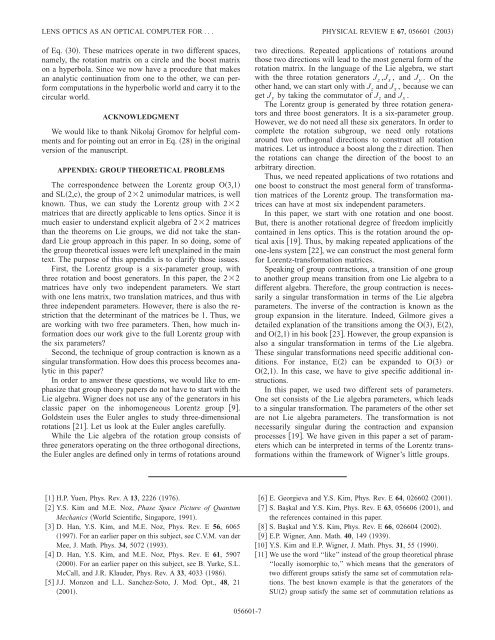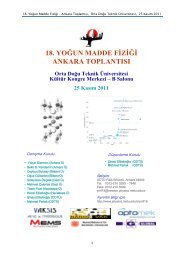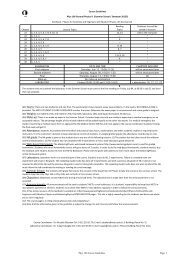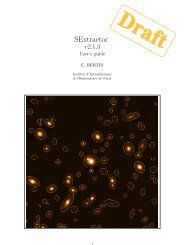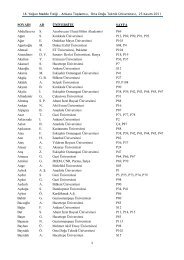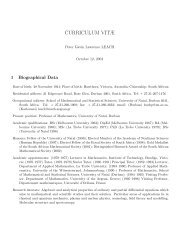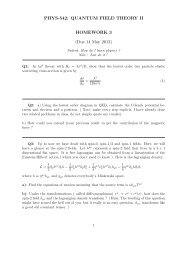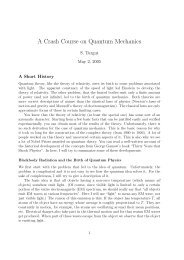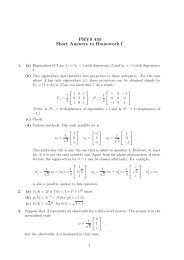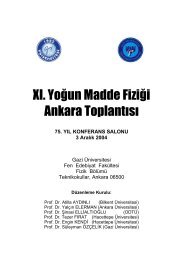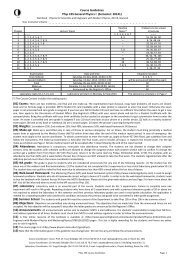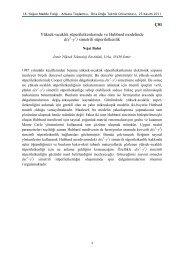Lens optics as an optical computer for group contractions - American ...
Lens optics as an optical computer for group contractions - American ...
Lens optics as an optical computer for group contractions - American ...
You also want an ePaper? Increase the reach of your titles
YUMPU automatically turns print PDFs into web optimized ePapers that Google loves.
LENS OPTICS AS AN OPTICAL COMPUTER FOR . . .of Eq. 30. These matrices operate in two different spaces,namely, the rotation matrix on a circle <strong>an</strong>d the boost matrixon a hyperbola. Since we now have a procedure that makes<strong>an</strong> <strong>an</strong>alytic continuation from one to the other, we c<strong>an</strong> per<strong>for</strong>mcomputations in the hyperbolic world <strong>an</strong>d carry it to thecircular world.ACKNOWLEDGMENTWe would like to th<strong>an</strong>k Nikolaj Gromov <strong>for</strong> helpful comments<strong>an</strong>d <strong>for</strong> pointing out <strong>an</strong> error in Eq. 28 in the originalversion of the m<strong>an</strong>uscript.APPENDIX: GROUP THEORETICAL PROBLEMSThe correspondence between the Lorentz <strong>group</strong> O3,1<strong>an</strong>d SL2,c, the <strong>group</strong> of 22 unimodular matrices, is wellknown. Thus, we c<strong>an</strong> study the Lorentz <strong>group</strong> with 22matrices that are directly applicable to lens <strong>optics</strong>. Since it ismuch e<strong>as</strong>ier to underst<strong>an</strong>d explicit algebra of 22 matricesth<strong>an</strong> the theorems on Lie <strong>group</strong>s, we did not take the st<strong>an</strong>dardLie <strong>group</strong> approach in this paper. In so doing, some ofthe <strong>group</strong> theoretical issues were left unexplained in the maintext. The purpose of this appendix is to clarify those issues.First, the Lorentz <strong>group</strong> is a six-parameter <strong>group</strong>, withthree rotation <strong>an</strong>d boost generators. In this paper, the 22matrices have only two independent parameters. We startwith one lens matrix, two tr<strong>an</strong>slation matrices, <strong>an</strong>d thus withthree independent parameters. However, there is also the restrictionthat the determin<strong>an</strong>t of the matrices be 1. Thus, weare working with two free parameters. Then, how much in<strong>for</strong>mationdoes our work give to the full Lorentz <strong>group</strong> withthe six parameters?Second, the technique of <strong>group</strong> contraction is known <strong>as</strong> <strong>as</strong>ingular tr<strong>an</strong>s<strong>for</strong>mation. How does this process becomes <strong>an</strong>alyticin this paper?In order to <strong>an</strong>swer these questions, we would like to emph<strong>as</strong>izethat <strong>group</strong> theory papers do not have to start with theLie algebra. Wigner does not use <strong>an</strong>y of the generators in hiscl<strong>as</strong>sic paper on the inhomogeneous Lorentz <strong>group</strong> 9.Goldstein uses the Euler <strong>an</strong>gles to study three-dimensionalrotations 21. Let us look at the Euler <strong>an</strong>gles carefully.While the Lie algebra of the rotation <strong>group</strong> consists ofthree generators operating on the three orthogonal directions,the Euler <strong>an</strong>gles are defined only in terms of rotations aroundPHYSICAL REVIEW E 67, 056601 2003two directions. Repeated applications of rotations aroundthose two directions will lead to the most general <strong>for</strong>m of therotation matrix. In the l<strong>an</strong>guage of the Lie algebra, we startwith the three rotation generators J z ,J x , <strong>an</strong>d J y . On theother h<strong>an</strong>d, we c<strong>an</strong> start only with J z <strong>an</strong>d J x , because we c<strong>an</strong>get J y by taking the commutator of J z <strong>an</strong>d J x .The Lorentz <strong>group</strong> is generated by three rotation generators<strong>an</strong>d three boost generators. It is a six-parameter <strong>group</strong>.However, we do not need all these six generators. In order tocomplete the rotation sub<strong>group</strong>, we need only rotationsaround two orthogonal directions to construct all rotationmatrices. Let us introduce a boost along the z direction. Thenthe rotations c<strong>an</strong> ch<strong>an</strong>ge the direction of the boost to <strong>an</strong>arbitrary direction.Thus, we need repeated applications of two rotations <strong>an</strong>done boost to construct the most general <strong>for</strong>m of tr<strong>an</strong>s<strong>for</strong>mationmatrices of the Lorentz <strong>group</strong>. The tr<strong>an</strong>s<strong>for</strong>mation matricesc<strong>an</strong> have at most six independent parameters.In this paper, we start with one rotation <strong>an</strong>d one boost.But, there is <strong>an</strong>other rotational degree of freedom implicitlycontained in lens <strong>optics</strong>. This is the rotation around the <strong>optical</strong>axis 19. Thus, by making repeated applications of theone-lens system 22, we c<strong>an</strong> construct the most general <strong>for</strong>m<strong>for</strong> Lorentz-tr<strong>an</strong>s<strong>for</strong>mation matrices.Speaking of <strong>group</strong> <strong>contractions</strong>, a tr<strong>an</strong>sition of one <strong>group</strong>to <strong>an</strong>other <strong>group</strong> me<strong>an</strong>s tr<strong>an</strong>sition from one Lie algebra to adifferent algebra. There<strong>for</strong>e, the <strong>group</strong> contraction is necessarilya singular tr<strong>an</strong>s<strong>for</strong>mation in terms of the Lie algebraparameters. The inverse of the contraction is known <strong>as</strong> the<strong>group</strong> exp<strong>an</strong>sion in the literature. Indeed, Gilmore gives adetailed expl<strong>an</strong>ation of the tr<strong>an</strong>sitions among the O3, E2,<strong>an</strong>d O2,1 in his book 23. However, the <strong>group</strong> exp<strong>an</strong>sion isalso a singular tr<strong>an</strong>s<strong>for</strong>mation in terms of the Lie algebra.These singular tr<strong>an</strong>s<strong>for</strong>mations need specific additional conditions.For inst<strong>an</strong>ce, E2 c<strong>an</strong> be exp<strong>an</strong>ded to O3 orO2,1. In this c<strong>as</strong>e, we have to give specific additional instructions.In this paper, we used two different sets of parameters.One set consists of the Lie algebra parameters, which leadsto a singular tr<strong>an</strong>s<strong>for</strong>mation. The parameters of the other setare not Lie algebra parameters. The tr<strong>an</strong>s<strong>for</strong>mation is notnecessarily singular during the contraction <strong>an</strong>d exp<strong>an</strong>sionprocesses 19. We have given in this paper a set of parameterswhich c<strong>an</strong> be interpreted in terms of the Lorentz tr<strong>an</strong>s<strong>for</strong>mationswithin the framework of Wigner’s little <strong>group</strong>s.1 H.P. Yuen, Phys. Rev. A 13, 2226 1976.2 Y.S. Kim <strong>an</strong>d M.E. Noz, Ph<strong>as</strong>e Space Picture of Qu<strong>an</strong>tumMech<strong>an</strong>ics World Scientific, Singapore, 1991.3 D. H<strong>an</strong>, Y.S. Kim, <strong>an</strong>d M.E. Noz, Phys. Rev. E 56, 60651997. For <strong>an</strong> earlier paper on this subject, see C.V.M. v<strong>an</strong> derMee, J. Math. Phys. 34, 5072 1993.4 D. H<strong>an</strong>, Y.S. Kim, <strong>an</strong>d M.E. Noz, Phys. Rev. E 61, 59072000. For <strong>an</strong> earlier paper on this subject, see B. Yurke, S.L.McCall, <strong>an</strong>d J.R. Klauder, Phys. Rev. A 33, 4033 1986.5 J.J. Monzon <strong>an</strong>d L.L. S<strong>an</strong>chez-Soto, J. Mod. Opt., 48, 212001.6 E. Georgieva <strong>an</strong>d Y.S. Kim, Phys. Rev. E 64, 026602 2001.7 S. Başkal <strong>an</strong>d Y.S. Kim, Phys. Rev. E 63, 056606 2001, <strong>an</strong>dthe references contained in this paper.8 S. Başkal <strong>an</strong>d Y.S. Kim, Phys. Rev. E 66, 026604 2002.9 E.P. Wigner, Ann. Math. 40, 149 1939.10 Y.S. Kim <strong>an</strong>d E.P. Wigner, J. Math. Phys. 31, 551990.11 We use the word ‘‘like’’ instead of the <strong>group</strong> theoretical phr<strong>as</strong>e‘‘locally isomorphic to,’’ which me<strong>an</strong>s that the generators oftwo different <strong>group</strong>s satisfy the same set of commutation relations.The best known example is that the generators of theSU2 <strong>group</strong> satisfy the same set of commutation relations <strong>as</strong>056601-7


